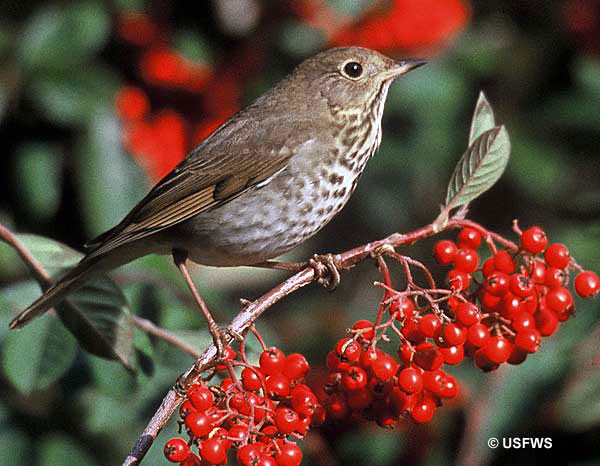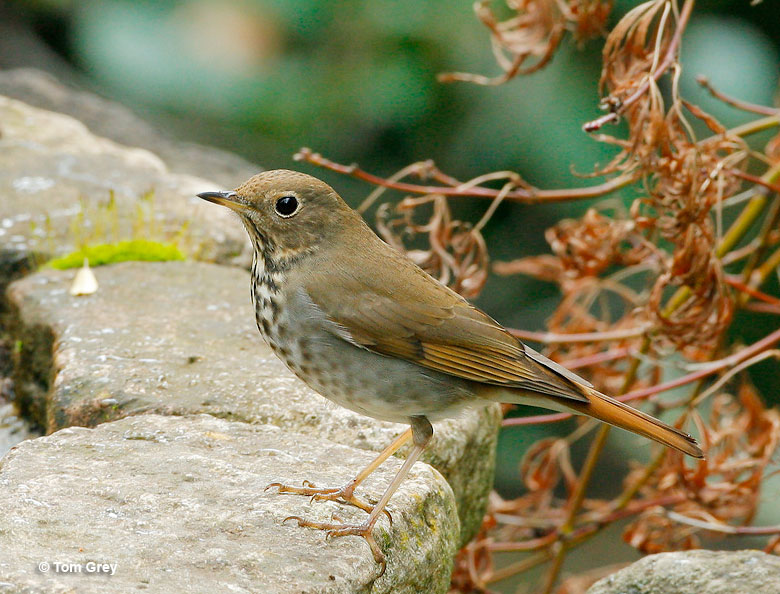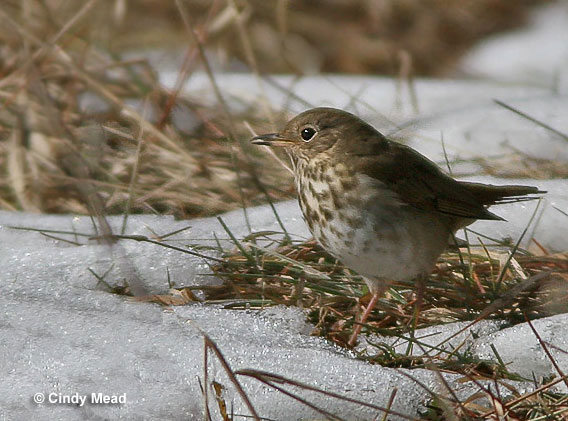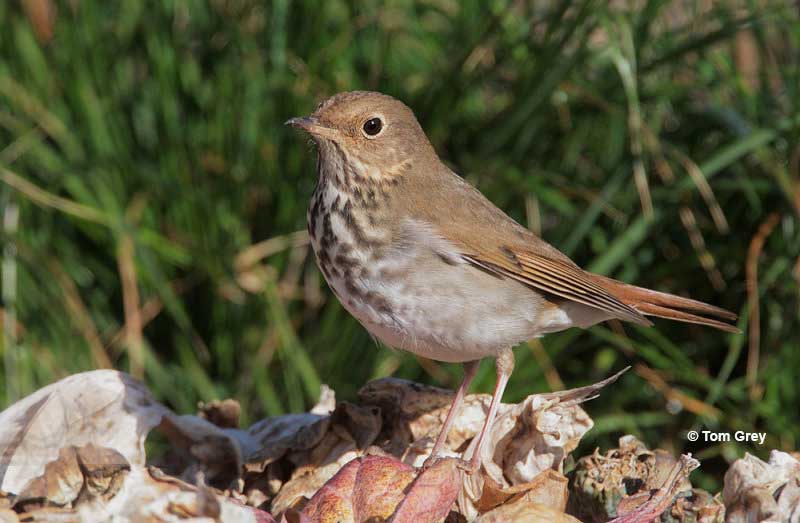
Vermont is a small New England state with 9,616 square miles of verdant forest, lakes, meadows, and quaint farms. More than 643,000 people share these beautiful places with nearly 400 bird species!
Vermont state bird is the beautiful Hermit Thrush. Folks in the Green Mountain State hear this lovely thrush’s beautiful song throughout Vermont.
On this page
State Bird of Vermont
The Hermit Thrush (Catharus guttatus) became the Vermont state bird on June 1, 1941. On this date, the Vermont Legislature voted to choose the Hermit Thrush to be an official state symbol.
This vote was actually overdue because, in 1927, the people of Vermont had already picked the Hermit Thrush to be the state bird. As with other states during the 1920s, local Federated Women’s Clubs were hosting campaigns to pick a state bird.
They worked with local Audubon clubs and garden clubs, and then usually organized a vote held in schools to pick the state bird. In Vermont, the Hermit Thrush was quickly chosen, but lawmakers didn’t have an official vote on it until 1941.

Even then, some lawmakers weren’t too keen on picking the Hermit Thrush. Some felt that since the bird migrated south for the winter, it wasn’t a true Vermonter!
They would have rather picked the American Crow or Blue Jay.
However, they changed their minds after fellow lawmakers and local birders explained that the Hermit Thrush was a common breeding bird throughout the state. Most of all, its song was one of the most beautiful bird songs in the USA and was a common feature of spring and summer in Vermont.
Fun Facts about Hermit Thrushes
- Hermit Thrushes don’t visit feeders. However, during migration, they will visit backyards to feed on berries. Landscaping for this and other bird species can bring them right into your backyard!
- This species sometimes forages by softly shaking grass with one of its feet. It does this to scare small insects out of hiding.
- Hermit Thrushes that live in the western USA nest in trees. Birds that breed in Vermont and other places east of the Rockies typically nest on the ground.
- Hermit Thrushes migrate south but are still the hardiest of the small thrushes. They can winter as far north as Pennsylvania and Washington state!
- Vermont is the only state with the Hermit Thrush as its official state bird. This species is a perfect choice for this heavily forested state.
- When a Hermit Thrush is about to fly, it usually flicks its wings and tail. If you are focusing on a Hermit Thrush and it makes these movements, don’t wait to take a picture!
- The Latin name of this bird, “Catharus guttatus” means pure and spotted. This name refers to the bird’s clear and beautiful song, and its heavily spotted underparts.
Identification
The Hermit Thrush is a small, brown thrush species a little bit larger than a House Sparrow. It is 6.75 inches long, has a wingspan of 11.5 inches, and weighs 1.1 ounces. Both sexes look the same but males are slightly larger and have longer wings. Female Hermit Thrushes have slightly longer beaks.
This small thrush is warm olive-brown above (more gray in the west), and usually has some red-brown coloration in its wings. It has a red-brown tail, and a pale eyering that is wider on the back part of its eye. These are two of the best field marks to separate Hermit Thrushes from similar thrush species like the Swainson’s Thrush and the Gray-cheeked Thrush.

Hermit Thrushes have a dark line on each side of their throat, and heavy dark spotting on their chest. The rest of their underparts are buff and white with pale brown and buff on their flanks and undertail.
They also have a pinkish or buff base on their bill, and rather long, pale pinkish legs.
Young Hermit Thrushes look like adults but have a line of small pale spots on their wings. In flight, both adults and young birds show a broad buff stripe on their underwings.
What do Hermit Thrushes eat?
Hermit Thrushes have a diet of insects, spiders, other arthropods, berries, and other small fruits. On occasion, they can also catch and eat salamanders and other small vertebrates.
These small thrushes eat a lot of caterpillars, moths, flies, small worms, beetles, and many other insects. In general, Hermit Thrushes catch and eat just about any small bug or invertebrate they can catch.
Although they can feed on bugs all year long, Hermit Thrushes eat a lot more insects during the spring and summer months, especially when nesting.
They forage for insects and other small creatures by standing on the ground in or next to forest and second growth. The thrush carefully looks around and if it sees a bug, quickly hops in to snatch it with its beak.
Hermit Thrushes can take bugs from low vegetation and the ground, and can also look for them by using their beak to lift small leaves. They will also use their foot to shake grass and scare insects out of hiding.
In fall and winter, Hermit Thrushes eat a lot more berries and other small fruits. They can feed on a wide variety of fruits, including pokeberries, elderberries, pokeberries, serviceberries, mistletoe berries, and grapes.
Call
Hermit Thrushes are vocal birds that make a variety of calls. One of their most common is a quiet, low-pitched “chuck” or “tchup” call. They can just make this call once or repeat it two or three times.
They also commonly make a quiet but shrill “zhreee” call, and a high-pitched descending “seeet” sound.
However, the most recognized sound of the Hermit Thrush is their song. In spring and summer, males repeat a phrase of ethereal, flute-like whistled vocalizations. It always starts with a clear note on one pitch followed by a couple of high-pitched warbling sounds. Their song sounds something like, “feeeee, cheedley cheedley.”
Behavior
Hermit Thrushes are fairly common but unobtrusive birds of forest and shaded second growth. They aren’t necessarily shy and can often be approached at close range, but usually prefer to stay under dense vegetation.
Every so often, one will forage in the open, especially in the early morning or late afternoon. However, to see Hermit Thrushes, you usually have to watch for them on forest trails or look for movement on the ground under bushes and other vegetation.
In summer, Hermit Thrushes live in cool northern and montane forests. In winter, we can see Hermit Thrushes in wooded canyons, wooded parks, and other forested areas, especially near streams and other moist spots.

They spend a lot of their time quietly foraging underneath vegetation but can also perch in low bushes to feed on berries. In spring, Hermit Thrushes build small cup nests on or close to the ground, often hidden next to a low bush or small dense conifer.
This species does not form flocks and is typically seen on its own. They don’t pose any threat to pets or people but can be very susceptible to being hunted by cats. These small birds also have to be careful of Cooper’s Hawks, other raptors, and other small predators.
Keep reading – Most common birds of Vermont
Frequently Asked Questions
What is the state bird of Vermont?
The state bird of Vermont is the Hermit Thrush.
Why is the Hermit Thrush the state bird of Vermont?
The Hermit Thrush is the state bird of Vermont because its beautiful song is commonly heard in every corner of the state.
When did Vermont choose its state bird?
Vermont chose its state bird on June 1, 1941.
What is Vermont’s state animal?
Vermont’s state animal is the Morgan Horse.
What is the state flower of Vermont?
The state flower of Vermont is the Red Clover.

